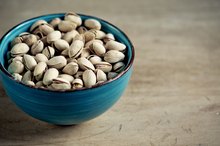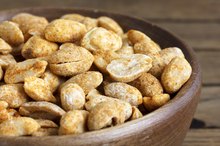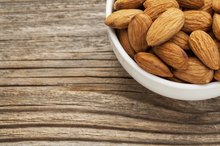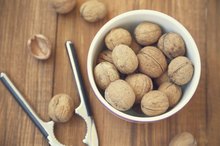5 Things You Need to Know About the Protein in Nuts
What Is Protein And Why Do I Need It?
Protein is found in every living thing, and it is made of various amino acids. While our body can create its own supply of many amino acids, there are nine that we need to get from dietary sources. "Complete" proteins, such as meat, quinoa and soybeans, provide us with all the dietary amino acids that our bodies need, and other good sources of protein include nuts, seeds, beans, lentils and whole grains. Fruits and vegetables also provide some protein. Protein requirements vary depending on age, sex and activity level, but generally you should get 30 to 60 grams of protein a day.
- Protein is found in every living thing, and it is made of various amino acids.
- Complete" proteins, such as meat, quinoa and soybeans, provide us with all the dietary amino acids that our bodies need, and other good sources of protein include nuts, seeds, beans, lentils and whole grains.
Go Nuts
Just because a protein source is "incomplete" does not make it inferior, and the old theory about combining protein sources in a single meal to create a complete protein has long since been discarded. Also, complete proteins are not necessarily healthy foods. Most meats, for example, are high in saturated fat and cholesterol. Ounce for ounce, nuts are one of the highest and healthiest sources of protein in the plant world, and they contain many essential amino acids. Peanuts and sunflower seeds lead the pack with 8 grams of protein in a 1/4 cup serving; almonds, pumpkin seeds and sesame seeds aren't too far behind with 7 grams of protein per 1/4 cup. Other high-protein nuts are walnuts, Brazil nuts, hazelnuts (filberts), pistachios and cashews.
- Just because a protein source is "incomplete" does not make it inferior, and the old theory about combining protein sources in a single meal to create a complete protein has long since been discarded.
- Other high-protein nuts are walnuts, Brazil nuts, hazelnuts (filberts), pistachios and cashews.
More Health Benefits
Nuts are full of fiber and a great source for many vitamins, minerals and antioxidants. Almonds, for example, provide iron, calcium and vitamin E. Cashews have vitamin A and peanuts offer zinc. While nuts are generally high in fat, it is largely unsaturated, the "good" kind of fat that can lower your cholesterol and boost your cardiovascular health. Many nuts and seeds, particularly walnuts, flax seeds and hemp seeds, are high in omega-3 fatty acids.
- Nuts are full of fiber and a great source for many vitamins, minerals and antioxidants.
- Many nuts and seeds, particularly walnuts, flax seeds and hemp seeds, are high in omega-3 fatty acids.
Recipe Suggestions
A handful of nuts makes a great high-energy snack. Chopped walnuts, pecans or almonds are a healthy, delicious addition to breads, cookies or muffins. Peanuts or cashews are great for sprinkling over a stir-fry, and walnuts, hazelnuts, chestnuts and almonds can be a hearty component in stews and casseroles. Pine nuts are good for more than just pesto; they can top pasta dishes, and a very tasty pesto can also be made from walnuts or pecans. Peanut butter isn't the only nut butter; there's also almond butter, cashew butter, sunflower butter and others.
- A handful of nuts makes a great high-energy snack.
- Chopped walnuts, pecans or almonds are a healthy, delicious addition to breads, cookies or muffins.
A Word About Allergies
Unfortunately, not everyone can take advantage of the health benefits of nuts. Nut are one of the most common allergens, and a severe allergic reaction can be life threatening. If you experience difficulty breathing, redness, swelling, hives or other symptoms after eating nuts, see your doctor immediately.
Related Articles
References
- Cleveland Clinic. Fat and calories. Updated April 2019.
- Slavin J, Carlson J. Carbohydrates. Adv Nutr. 2014;(5)6:760-1. doi:10.3945/an.114.006163
- US Department of Agriculture. FoodData Central.
- Liu AG, Ford NA, Hu FB, Zelman KM, Mozaffarian D, Kris-etherton PM. A healthy approach to dietary fats: understanding the science and taking action to reduce consumer confusion. Nutr J. 2017;(16)1:53. doi:10.1186/s12937-017-0271-4
- Hever J, Cronise RJ. Plant-based nutrition for healthcare professionals: implementing diet as a primary modality in the prevention and treatment of chronic disease. J Geriatr Cardiol. 2017;(14)5:355-368. doi:10.11909/j.issn.1671-5411.2017.05.012
- Gupta RK, Gangoliya SS, Singh NK. Reduction of phytic acid and enhancement of bioavailable micronutrients in food grains. J Food Sci Technol. 2015;(52)2:676-84. doi:10.1007/s13197-013-0978-y
- Wang TY, Liu M, Portincasa P, Wang DQ. New insights into the molecular mechanism of intestinal fatty acid absorption. Eur J Clin Invest. 2013;(43)11:1203-23. doi:10.1111/eci.12161
- US National Library of Medicine. Soluble vs. insoluble fiber. Updated June 2018.
- Academy of Nutrition and Dietetics. Gluten free diet: building the grocery list. November 2018.
- Harvard Medical School. Quick-start guide to nuts and seeds. September 2019.
- Zhivagui M, Ng AWT, Ardin M, et al. Experimental and pan-cancer genome analyses reveal widespread contribution of acrylamide exposure to carcinogenesis in humans. Genome Res. 2019;(29)4:521-531. doi:10.1101/gr.242453.118
- Iweala OI, Choudhary SK, Commins SP. Food Allergy. Curr Gastroenterol Rep. 2018;(20)5:17. doi:10.1007/s11894-018-0624-y
- American College of Allergy, Asthma, and Immunology (ACAAI). Newly Issued Clinical Guidelines from the NIAID Recommend the Early Peanut Introduction, Not Avoidance. Milwaukie, Wisconsin; press release issued January 5, 2017.
- Du Toit. G.; Roberts, G.; Sayer, P. et al. Randomized Trial of Peanut Consumption in Infants at Risk for Peanut Allergy. N Engl J Med. 2015; 372:803-13. DOI: 10.1056/NEJMoa1414850.
- McMacken M, Shah S. A plant-based diet for the prevention and treatment of type 2 diabetes. Journal of Geriatric Cardiology : JGC. 2017;14(5):342-354. DOI: 10.11909/j.issn.1671-5411.2017.05.009.
- Tuso PJ, Ismail MH, Ha BP, Bartolotto C. Nutritional update for physicians: plant-based diets. Perm J. 2013;17(2):61-6. DOI: 10.7812/TPP/12-085.
- Wright, N., Wilson, L., Smith, M., Duncan, B., & McHugh, P. (2017). The BROAD study: A randomised controlled trial using a whole food plant-based diet in the community for obesity, ischaemic heart disease or diabetes. Nutrition & Diabetes, 7(3), e256–e256. DOI: 10.1038/nutd.2017.3.
- Preedy, V.; Watson, R.; and Patel, V. (2011) Nuts and Seeds in Health and Disease Prevention (1st Edition). New York: Academic Press. ISBN: 9780123756886.
Writer Bio
This article was written by the CareerTrend team, copy edited and fact checked through a multi-point auditing system, in efforts to ensure our readers only receive the best information. To submit your questions or ideas, or to simply learn more about CareerTrend, contact us [here](http://careertrend.com/about-us).









